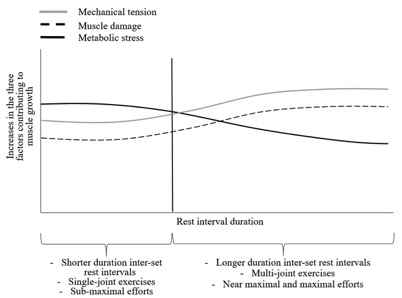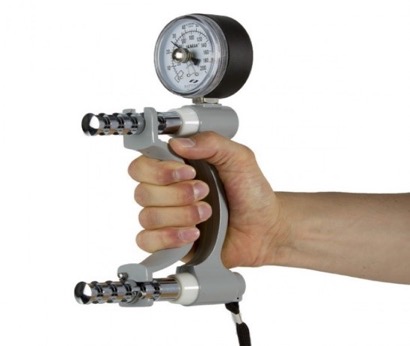New Age Hypertrophy
Maximum efficiency, to make the task as best as possible in the shortest time has become a symbol of the future. Finding ways to add those few percent that can make differences is essential to athletes for increasing exercise performance and to recreational population for optimizing their training and mitigating negative aspects of modern sedentary lifestyle. Now, what does that have to do with hypertrophy? Let’s start with the basics.
Hypertrophy is a hot topic in both scientific and practical terms. The term “hypertrophy” refers to the increase in cross-sectional area of muscle, i.e. muscle increase. There are many variables of training that can affect muscle hypertrophy and some of them are:
- volume
- frequency
- number of repetitions
- rest intervals
Of all the above variables it seems that the volume of training is critical. (8) Recent research suggests that there should be at least 10 series per muscle group on weekly basis (the upper limit of weekly volume is not yet exact) with a frequency of at least 2 times a week per muscle group. (8)
What about the number of repetitions?
It has long been considered that range of 6-12 repetitions is the best for hypertrophy and that depending on the number of repetitions selective hypertrophy (sarcoplasmic or myofibrilar) is possible. However due to new recent works story has slightly changed. Recent meta-analysis of Schoenfeld and collaborators (8) has shown that hypertrophy is equal independently of the number of repetitions (if repetitions were made to exhaustion). In other words, you can also train with fewer repetitions (up to 10) as well as multiple repetitions (+ 20) and achieve the same hypertrophic effects if these repetitions are performed to exhaustion.
The question that arises is – Can we do better than these 6-12 repetitions?
Yes! Train through the entire spectrum of repetitions. One way to do it is to put the focus on larger muscle groups at the beginning of the training, to practice with higher loads with fewer repetitions (up to 10) and take longer rest periods. If you train like this you automatically put a big emphasis on mechanical stress which is the key to achieving hypertrophy. After that, in the second part of the training, focus on smaller muscle groups and do a higher number of repetitions (+ 20) with shorter intervals of rest with smaller weights for greater metabolic stress. You can view the schematic of this training mode in Figure 1.
Figure 1. New hypertrophy training schema

By training like this you can encourage muscle hypertrophy through multiple mechanisms, which should give maximal results (at least in theory).
Another interesting thing that recent literature suggests is that the training with a larger external load will affect the hypertrophy of type II fibers more and the training with a smaller external load the type I fibers. (6, 7, 9) However, it is possible that this answer is specific depending on the muscle groups. Thus, it is important to know which muscles possess which fibers.
The number of studies that have dealt with this is small and there are no exclusive results but the current results (10-22) on larger muscles suggest the following:
Pectoralis major – dominantly type II (CCA 60%)
Latissimus dorsi – dominantly type II (CCA 65%)
Gluteus maximus – Mix
Quadriceps femoris – Mix
Hamstrings – Mix
Trapezius – Mix
Deltoideus – Mix
Soleus – the dominant type I (70-96%)
Gastrocnemius – dominantly type II (44-76%)
Abdominal (rectus abdominal, Internal, External Oblique) – Mix (55-58% slow)
Erectori Spine – Dominant type I (approx 70%)
Aduktori – Mix
Biceps brachii – dominantly type II 60%
Triceps brachii – dominantly type II 60%
Now that we know that, we know with what intensity we should strain the individual muscle to get even better results.
Training only with 6-12 repetitions?
– If you want maximal results, you can FORGET about these recommendations!
- https://fitnes-uciliste.hr/vodic-kroz-misicna-vlakna/
- https://fitnes-uciliste.hr/jesu-li-hipertrofijske-adaptacije-na-razlicita-vanjska-opterecenja-specificne-prema-misicnim-vlaknima/
- https://fitnes-uciliste.hr/okluzijski-trening-trening-s-ogranicenim-protokom-krvi/
- https://renaissanceperiodization.com/muscle-fiber-types-change-training-end-unfounded-debate/
- https://academic.oup.com/ptj/article/81/11/1810/2857618
- Netreba A, Popov D, Bravyy Y et al. Responses of knee extensor muscles to leg press training of various types in human. Ross Fiziol Zh Im I M Sechenova 2013; 99(3):406-416.
- Vinogradova OL, Popov DV, Netreba AI et al. Optimization of training: development of a new partial load mode of strength training. Fiziol Cheloveka 2013; 39(5):71-85.
- Schoenfeld BJ, Grgic J, Ogborn D et al. Strength and hypertrophy adaptations between low- versus high-load resistance training: A systematic review and meta-analysis. J Strength Cond Res In press.
- Ogborn D, Schoenfeld BJ. The role of fiber types in muscle hypertrophy: implications for loading strategies. Strength Cond J 2014; 36(2):20-25.
- https://www.strengthandconditioningresearch.com/muscles



